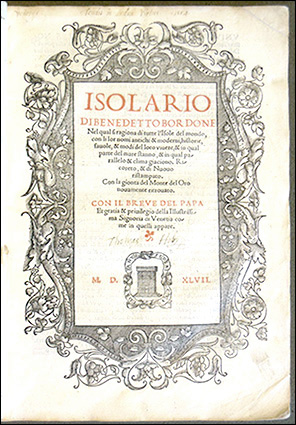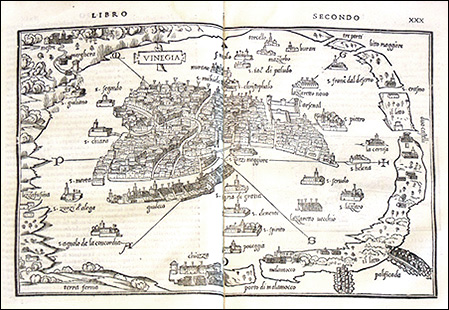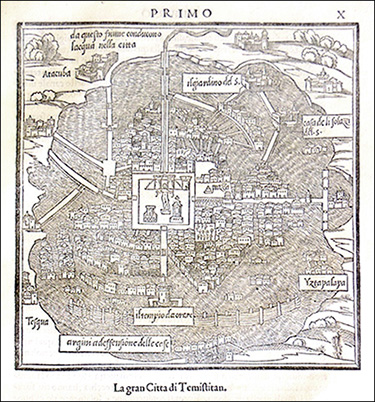A book from the library of an Elizabethan traveler
Venice was an appropriate place for a cartographer like Benedetto Bordone to publish his Isolario, a book about islands ancient and modern. Originally printed in 1528, the work would go through several editions and inspire other books on the subject. Although intended as an illustrated guide for sailors, it enjoyed greater popularity with armchair travelers eager to learn about parts of the world most of them would never see.
The Isolario is remarkable for several reasons. Previous maps had relied heavily on the writings of the ancient Greek geographer Ptolemy. Renaissance scholars, though admirers of classical wisdom, had to face the facts and admit that Ptolemy was dead wrong about a lot of things. Bordone was among a new generation of cartographers who based their maps on reports sent in by contemporary explorers. His oval depiction of the world was a novelty at the time, as were his aerial views of cities, such as the famous view of the Venetian lagoon.
The Isolario also depicted new discoveries in the Americas. It contains what is thought to be the earliest printed account of Francisco Pizarro's conquest of the Incas of Peru and also a map of the Aztec capital, Tenochtitlan (built on an island in the middle of Lake Texcoco), around the time of its destruction by Hernan Cortez. Additionally, towards the back of the book, we find a map of "Ciampagu" — the first European map of Japan.
LSU's 1547 edition of the Isolario is remarkable for another reason. The title page bears the signature of Sir Thomas Hoby and his Latin motto, "Tendit in ardua virtus" ("To direct upon lofty valor"), dated 1554. It would be hard to find a travel book with a better provenance. Hoby, born into the English gentry in 1530, traveled extensively in Europe during his youth and was one of the pioneers of the Grand Tour. During the tumultuous reign of Queen Mary, he went into exile, devoting part of his time to translating Baldassare Castiglione's Il Cortegiano (The Courtier), a manual of etiquette that became one of the most popular and influential books of the Renaissance. Queen Elizabeth knighted Hoby in 1566 before sending him as an ambassador to France, where he died a few months later at the age of 36.
Sir Thomas Hoby's copy of the Isolario may be consulted freely in the Special Collections Reading Room. The call number is: Rare Book Collection G500 .B7 1547 Oversize.
- Michael Taylor, Assistant Curator of Books



